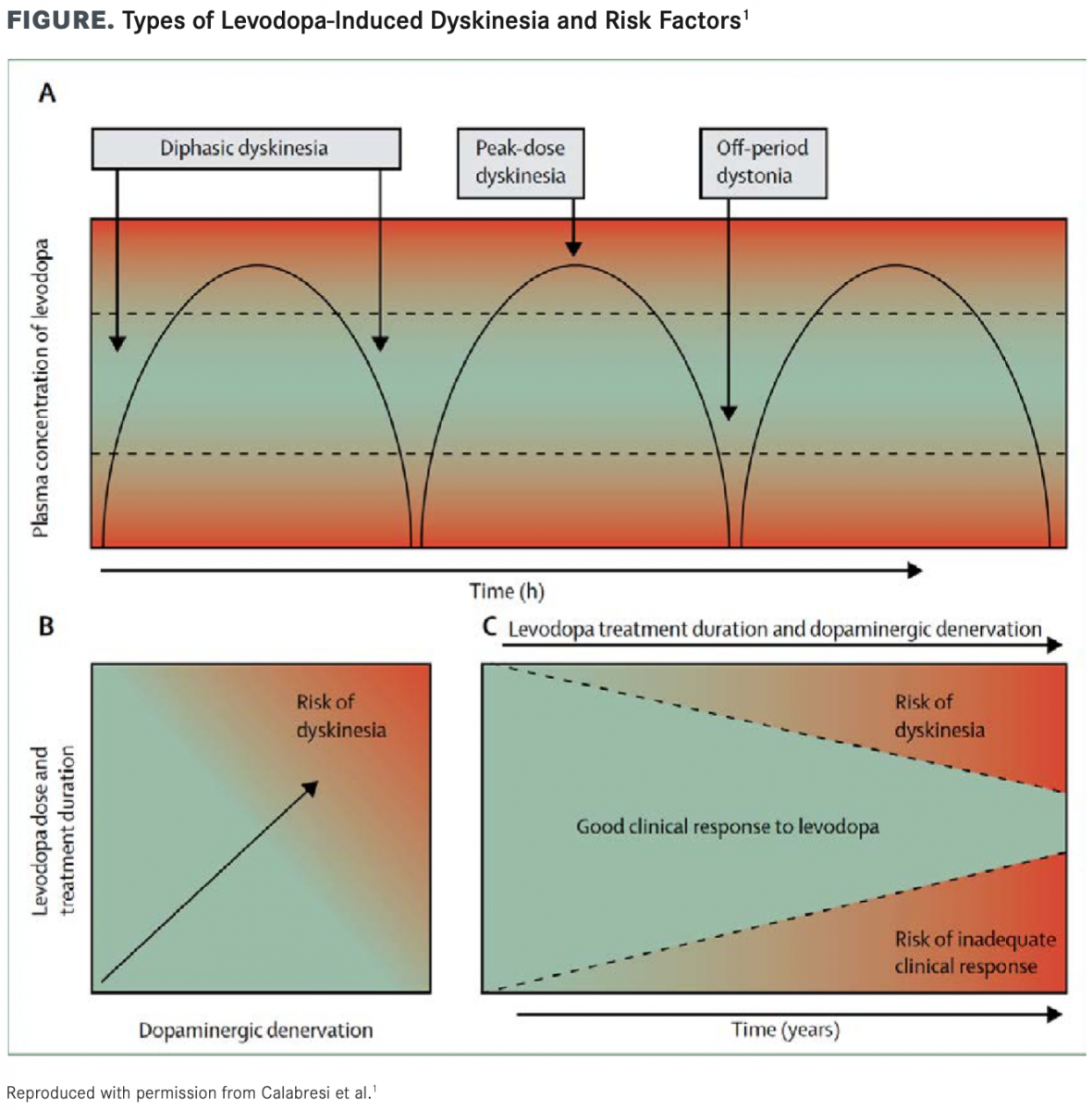Keeping Treatment Response "On" in Parkinson Disease
New drug classes and formulations may help hold off breakthrough activity as the research community works to optimize levodopa delivery and absorption.

Stuart Isaacson, MD
Despite the medical breakthrough of an orally available precursor compound that is converted after crossing the blood- brain barrier to replenish a diminished dopamine neurotransmitter in the brain, the initial consistent therapeutic response to levodopa in patients with Parkinson disease (PD) will eventually wane into “off” periods.
“After several years, sometimes as early as 1 or 2 years, sometimes in 4 or 5 years, but usually in the first couple of years, this so-called honeymoon period begins to end, and many patients begin to notice that 3 or 4 hours after taking a dose of carbidopa/levodopa, their symptoms return and break through,” Stuart Isaacson, MD, director and founder of the Parkinson’s Disease and Movement Disorders Center of Boca Raton in Florida, told NeurologyLive®. “These symptoms can be motor or nonmotor, but when these symptoms come out at the end of a dose, we call it the beginning of an off period.”
Practitioners can address the emergence of PD symptoms in off periods of response to the treatment mainstay levodopa by ensuring therapeutic levels, as well as with adjunctive treatment or alternative dopaminergic agents. Yet even with optimizing therapeutic interventions, symptoms can worsen with the degeneration of dopaminergic neurons as the disease progresses. The challenge of maintaining optimal levodopa therapy also increases over years of treatment and with disease progression. Paolo Calabresi, MD, of the Clinica Neurologica at the Università degli Studi di Perugia in Italy, and colleagues described a narrowing window for therapeutic effect and a widening likelihood of either peak-dose dyskinesias or subtherapeutic off dystonia (FIGURE).1
The manifestations of oscillation between on and off response to treatment include wearing off, delayed on, no on, and akinesia, typically in the early morning. “These are generally considered to be among the most troublesome symptoms by [patients with] advanced PD,” observed Werner Poewe, MD, and Philipp Mahlknecht, MD, PhD, of the Department of Neurology at the Medical University of Innsbruck in Austria.2
Poewe and Mahlknecht related the dyskinesias to an on-off cycle with on-period chorea, biphasic dyskinesias, and off-period dystonias that are often painful. Although severe, disabling dyskinesias are less frequent, but they do require medical attention. Milder forms of dyskinesia are more frequent but generally do not require changes in treatment, Poewe and Mahlknecht suggested, “if other components of motor function are adequately maintained.”2
The risk of levodopa-induced motor complications has previ- ously given rise to debate about withholding levodopa therapy until required in later PD, particularly in patients younger than 70 years, Poewe and Mahlknecht noted, with the hope that these adverse effects might also be delayed. That position is supported by the association of levodopa-induced motor complications with a cumulative amount of levodopa, as well as higher daily doses (≥400 mg and/or >4 mg/kg). However, an association exists with longer duration of PD at the initiation of levodopa and with early-onset PD.
In a recent Viewpoint column in JAMA Neurology, Jorik Nonnekes, MD, PhD, of the Radboud University Medical Centre; Donders Institute for Brain, Cognition and Behaviour; Department of Rehabilitation, in Nijmegen, the Netherlands, and colleagues suggested that freezing of gait (FOG) might also be a manifestation of levodopa treatment and a reflection of the peak and valley levels from traditional levodopa regimens.3
“It is accepted that long-term levodopa treatment, possibly because of its pulsatile administration, results in loss of compensatory postsynaptic dopaminergic receptor upregulation and maladaptive plasticity of the striatum via influence on physiological forms of synaptic plasticity,” Nonnekes and colleagues wrote.3
They posited that FOG may reflect levodopa-induced aberrant plasticity, with increased thresholds of postsynaptic receptors within the motor circuitry connecting the striatum, premotor area, and supplementary motor area, necessitating higher dopamine concentrations for activation. “In the off-medication state, it is more difficult to overcome the higher-than-normal stimulation thresholds within the motor circuitry, so FOG is typically more severe in this state than the on-state,” Nonnekes and colleagues wrote.3 Although increasing levodopa dosage would initially meet the higher threshold, they suggested, over the long term, the higher dosage will further stimulate maladaptive plasticity, producing higher thresholds and greater FOG severity.3
Arguing against delaying levodopa until later stages of PD to avoid motor complications, however, Poewe and Mahlknecht pointed out that delaying the treatment, particularly with the need to start with
a higher dosage for more severe symptoms, is generally associated with a shortened period of therapeutic effect before motor complications begin.2 “Therefore, the current common approach is to introduce levodopa as soon as needed to maintain good symptom control
and quality of life,” they said.2

Optimizing Levodopa Levels
At the onset of response oscillations and levodopa-induced motor complications, practitioners must manage the pharmacological regimen to provide more continuous and reliable dopaminergic drug delivery.2 This is typically accomplished by increasing the dosage, dividing the levodopa dosage into smaller but more frequent doses, or by modifying the pharmacokinetics of the levodopa administration.
“We believe that levodopa continues to work throughout the decades-upon-decades—long course that some patients have Parkinson disease,” Isaacson said. “That is, you do not become ‘resistant’ to levodopa. The need for taking higher doses of levodopa or doses closer together or both reflects, we think, both problems that occur in changes in the brain itself and problems that occur in its absorption through the [gastrointestinal] system,” he added.
The factors that can affect the pharmaco- kinetics and contribute to loss of levodopa effect include changes in the absorption and assimilation of the medication, according to Harsh V. Gupta, MD, of the Department of Neurology at The University of Kansas Medical Center in Kansas City, Kansas, and colleagues.4 “As the disease progresses, variations in plasma levodopa levels lead to motor fluctuations,” they wrote.4 “The common reasons behind variations in the plasma levels include delayed gastric emptying, small intestinal overgrowth, protein interaction with levodopa absorption, and limited oral bioavailability of levodopa.”
Isaacson elaborated on these pharmacokinetic and pharmaco-dynamic challenges. “This really reflects the combination of trying to replace an essential neurotransmitter like dopamine by swallowing its precursor, the circuitous route it takes and the short half-life in the bloodstream, and the difficulty with storage in the brain,” he said. “So we always look for ways of trying to adjust the timing of taking the oral [dose]. We try to use extended deliveries of levodopa, either in oral or nonoral formulations, or we look at ways of trying to make a dose begin to work quicker.”
Gupta and colleagues described a variety of formulations of levodopa or levodopa-carbidopa that circumvent or mitigate these potential barriers to maintaining optimal levels. The products—now available, in development, or currently used outside the United States—include controlled or extended-release oral formulations, orally disintegrating and inhaled formulations, and frequently dosed microtablets, as well as more invasive formulations such as intrajejunal infusion and subcutaneous injection and infusion.4
Among the novel formulations is the inhaled form of levodopa, Inbrija (Acorda), approved by the FDA in 2018 for treatment of off episodes.5 Gupta and colleagues noted that in the pivotal randomized trials, self-administration during off periods led to a rapid improvement in symptoms.
Another distinctive formulation of carbidopa-levodopa is a pellet-like microtablet, currently available in Sweden. The microtablets are taken from an automatic dose dispenser, programmed with an alarm to remind patients. “The concept behind using a microtablet is to give a more frequent but decreased individual dose of levodopa, which leads to a reduction in fluctuations,” Gupta and colleagues said.4
Adjuncts and Alternatives to Reduce Off Periods
In addition to modifying carbidopa-levodopa formulations to optimize drug levels, enzyme inhibition strategies are used to increase drug effect by prolonging synaptic availability of dopamine. Monoamine oxidase B (MAO-B) inhibitors and catechol-O-methyltransferase (COMT) inhibitors have been used as add-on treatments to reduce off periods, as well as in levodopa-carbidopa “sparing” regimens.2
Since the introduction of MAO-B and COMT inhibitors, novel formulations have also been developed to facilitate the administration and enhance the bioavailability of these products. The MAO-B inhibitor selegiline, for example, received initial FDA approval as a 10-mg oral tablet in 1989, and in 2006, the FDA approved a 1.25-mg orally disintegrating tablet, Zelapar (Valeant Pharmaceuticals), based on data demonstrating it provided similar plasma levels.6 In April 2020, the agency also approved the first once-daily dosage form of the COMT inhibitor opicapone (Ongentys; Neurocrine Biosciences) as add-on treatment to decrease off periods and increase on time without dyskinesia.7
An additional approach to reduce off periods with a recently approved adjunct targets the adenosine A2a receptors, which are localized on cell bodies and terminals in the indirect striatal output pathway and are involved in development of motor fluctuations. Intermittent, pulsatile levodopa therapy leads to upregulation of A2a receptors, increasing stimulatory output and reduced motor activa- tion and contributing to the off periods in treatment response.8
The A2a receptor antagonist istradefylline (Nourianz; Kyowa Kirin) received approval9 in August 2019 as an adjunct to treat off episodes in patients with PD receiving levodopa. The FDA initially turned it away in 2008, requesting more data.10
"I think we have to have more treatment strategies where we try to educate our patients to recognize the symptoms, motor and nonmotor, that they experience and to recognize fluctuations that can occur... and the types of off episodes and when they can occur," stated Stuart Isaacson, MD.
The subsequent application to the FDA was supported by four 12-week, placebo-controlled trials that included a total of 1143 participants (NCT00456586, NCT00199407, NCT00455507, NCT00955526). “In all 4 studies, patients treated with Nourianz experienced a statistically significant decrease from baseline in daily off time compared to patients receiving a placebo,” the FDA indicated in announcing the approval.9
In their review of the clinical trials with istradefylline, Alok Singh, MD, of the Department of Pharmacology, All India Institute of Medical Sciences, Raipur in Chhattisgarh, India, and colleagues found a comparable efficacy with the COMT and MAO-B inhibitors in reducing daily off periods.8 One advantage of istradefylline over these agents, they pointed out, is that it lacks the potential drug interactions with antidepressants and many other drugs acting on the central nervous system.
If these measures fail to substantially reduce off periods, alternative dopaminergics may be useful. Apomorphine has been particularly valuable as a rescue measure. Gupta and colleagues attributed this to apomorphine acting on all dopamine receptor subtypes as well as on serotonergic and adrenergic receptors, in contrast with other dopamine agonists such as pramipexole and ropinirole, which have relatively selective affinity for the dopamine D2 receptor.4
In addition to the currently available intermittent subcutaneous injection (Apokyn; US WorldMeds), the FDA recently approved 2 new acute options. In May, the agency granted approval to Sunovion Pharmaceuticals’ apomorphine sublingual film (Kynmobi), the first sublingual therapy for this indication.11 The novel delivery route is meant to avoid gastrointestinal absorption issues commonly observed in patients with PD, allowing for improvement in motor symptoms in as little as 15 minutes post dose. The new drug application was supported by data from the phase 3 CTH-300 trial (NCT02469090), in which apomorphine sublingual film demonstrated significant improvements in motor function compared with placebo. The mean change in Unified Parkinson’s Disease Rating Scale (UPDRS) part III at 30 minutes post treatment at week 12 was —11.1 points with apomorphine sublingual film compared with –3.5 points with placebo, representing a 7.6-point difference between the 2 groups (P = .0002).12 During the maintenance phase, more patients treated with the study drug reported being fully on at 30 minutes post dose compared with those receiving placebo (P = .04).
Late in 2018, the FDA approved Acorda Therapeutics’ inhaled levodopa powder, Inbrija.13 The application was supported by findings from the pivotal phase 3 SPAN-PD trial (NCT02240030), a 12-week, randomized, double-blind, placebo-controlled study in patients with mild to moderate PD experiencing off periods. The trial met its primary end point, with patients on the study drug experiencing a 9.83-point reduction on the UPDRS part III 30 minutes post dose compared with a 5.91-point reduction in the placebo group (P = .009). Notably, onset of action was observed as early as 10 minutes post dose.13
Such new delivery systems and formulations not only provide additional treatment options, Gupta and colleagues wrote, “but, in many cases, have also allowed for improved symptom control and improved quality of life for those living with PD.”4
The array of therapeutic agents and formulations and the number in clinical testing are a welcome but challenging development, Isaacson indicated. “It’s both challenging [and exciting], and we’re quite lucky to have so many treatment options for people who live with Parkinson disease. I think we have to have more treatment strategies where we try to educate our patients to recognize the symptoms, motor and nonmotor, that they experience,” he said, “and to recognize fluctuations that can occur, resulting in off episodes, and the types of off episodes and when they can occur.”
To facilitate patient education and elicit details about the patient’s experience that could help to inform treatment choice, Isaacson recommended that patients keep a diary of symptoms for 2 or 3 days prior to a visit, addressing the following questions:
- How long does it take for the first oral levodopa dose to begin to work?
- What symptoms improve when it begins to work?
- How long does the improvement last during that on period?
- What symptoms begin to return at the end of a dose interval?
- How do the symptoms continue or worsen?
- At what time (interval) do they take each subsequent dose?
- How long does it take for each dose to work, before the symptoms improve again and the off episode ends?
“It’s a combination of educating ourselves and our patients and their caregivers about all the different treatment options,” Isaacson explained. “We have a number that are approved and a couple dozen medicines in research programs that give us great hope in trying to treat the motor and nonmotor symptoms and the fluctuations even better over time. Through shared clinical decision-making with our patients and their families and caregivers, [we can] find which option is best.”
References
1. Calabresi P, Di Filippo M, Ghiglieri V, Tambasco N, Picconi B. Levodopa-induced dyskinesias in patients with Parkinson’s disease: filling the bench-to-bedside gap. Lancet Neurol. 2010;9(11):1106- 1117. doi:10.1016/S1474-4422(10)70218-0
2. Poewe W, Mahlknecht P. Pharmacologic treatment of motor symptoms associated with Parkinson disease. Neurol Clin. 2020;38(2):255-267. doi:10.1016/j.ncl.2019.12.002
3. Nonnekes J, Bereau M, Bloem B. Freezing of gait and its levodopa paradox. JAMA Neurol. 2020;77(3):287-288. doi:10.1001/jamaneurol.2019.4006
4. Gupta HV, Lyons KE, Pahwa R. Old drugs, new delivery systems in Parkinson’s disease. Drugs Aging. 2019;36(9):807-821. doi:10.1007/s40266-019-00682-9
5. Drug approval package: Inbrija. FDA. Updated May 28, 2019. Accessed May 5, 2020. https://www.accessdata.fda.gov/drugsatfda_docs/nda/2018/209184Orig1s000TOC.cfm
6. Valeant Pharmaceuticals receives FDA approval of Zelapar for patients with Parkinson’s disease; Zelapar significantly reduces “off” time through unique delivery mechanism. News release. Valeant Pharmaceuticals. June 15, 2006. Accessed May 5, 2020. https://www.businesswire.com/news/home/20060615005238/en/Valeant-Pharmaceuticals-Receives-FDA-Approval-Zelapar-Patients
7. Neurocrine Biosciences announces FDA approval of once-daily Ongentys (opicapone) as an add-on treatment for patients with Parkinson’s disease experiencing “off” episodes,. News release. Neurocrine Biosciences. April 27, 2020. Accessed May 5, 2020. http://www.multivu.com/players/English/8719751-neurocrine-biosciences-ongentys/
8. Sahoo AK, Gupta D, Singh A. Istradefylline: a novel drug for ‘off’ episodes in Parkinson’s disease. Drug Ther Perspect. 2020;36:208-212. doi:10.1007/s40267-020-00718-w
9. FDA approves new add-on drug to treat off episodes in adults with Parkinson’s disease. News release. FDA. August 27, 2019. Accessed May 5, 2020. https://www.fda.gov/news-events/press-announcements/fda-approves-new-add-drug-treat-episodes-adults-parkinsons-disease
10. Kyowa Hakko receives not approvable letter from FDA for Istradefylline (KW-6002). News release. Kyowa Hakko Kogyo. February 28, 2008. Accessed May 5, 2020. https://www.fiercebiotech.com/biotech/kyowa-hakko-receives-not-approvable-letter-from-fda-for-istradefylline-kw-6002
